For the 2025 school year, there is 1 public middle school serving 382 students in Hannibal Central School District. This district's average middle testing ranking is 1/10, which is in the bottom 50% of public middle schools in New York.
Public Middle School in Hannibal Central School District have an average math proficiency score of 18% (versus the New York public middle school average of 40%), and reading proficiency score of 28% (versus the 51% statewide average).
Minority enrollment is 1% of the student body (majority Hispanic), which is less than the New York public middle school average of 63% (majority Hispanic).
Overview
This School District
This State (NY)
# Schools
3 Schools
1,659 Schools
# Students
1,252 Students
890,054 Students
# Teachers
113 Teachers
83,739 Teachers
Student : Teacher Ratio
11:1
11:1
District Rank
Hannibal Central School District, which is ranked #922 of all 1,015 school districts in New York (based off of combined math and reading proficiency testing data) for the 2021-2022 school year.
The school district's graduation rate of 75-79% has stayed relatively flat over five school years.
Overall District Rank
#919 out of 1020 school districts
(Bottom 50%)
(Bottom 50%)

Math Test Scores (% Proficient)
30%
46%
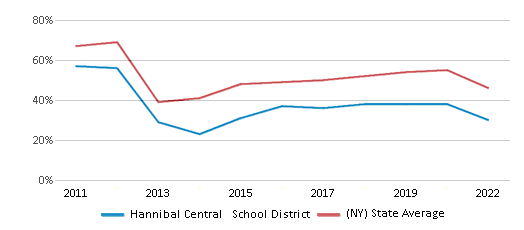
Reading/Language Arts Test Scores (% Proficient)
29%
49%
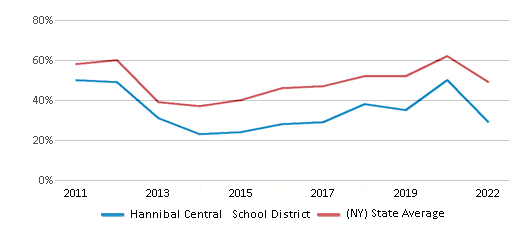
Science Test Scores (% Proficient)
69%
78%
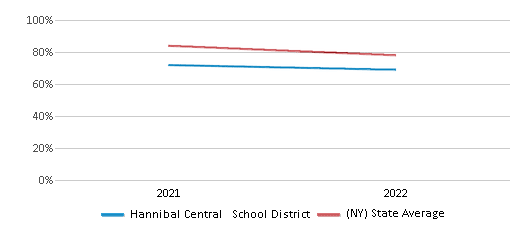
Graduation Rate
75-79%
87%
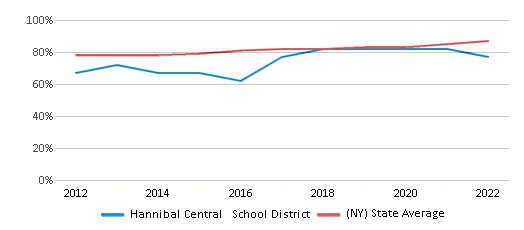
Students by Ethnicity:
Diversity Score
0.04
0.73
# American Indian Students
1 Student
7,222 Students
% American Indian Students
n/a
1%
# Asian Students
1 Student
81,213 Students
% Asian Students
n/a
9%
# Hispanic Students
17 Students
270,400 Students
% Hispanic Students
1%
30%
# Black Students
1 Student
175,155 Students
% Black Students
n/a
20%
# White Students
1,225 Students
325,608 Students
% White Students
98%
37%
# Hawaiian Students
1 Student
2,099 Students
% Hawaiian Students
n/a
n/a
# Two or more races Students
6 Students
28,478 Students
% of Two or more races Students
1%
3%
Students by Grade:
# Students in PK Grade:
72
8,468
# Students in K Grade:
94
26,528
# Students in 1st Grade:
90
28,304
# Students in 2nd Grade:
81
28,365
# Students in 3rd Grade:
74
27,931
# Students in 4th Grade:
79
29,265
# Students in 5th Grade:
101
43,975
# Students in 6th Grade:
85
157,405
# Students in 7th Grade:
102
185,375
# Students in 8th Grade:
90
188,665
# Students in 9th Grade:
91
40,472
# Students in 10th Grade:
95
36,147
# Students in 11th Grade:
74
33,448
# Students in 12th Grade:
109
33,009
# Ungraded Students:
15
22,697
District Revenue and Spending
The revenue/student of $29,805 in this school district is less than the state median of $31,307. The school district revenue/student has stayed relatively flat over four school years.
The school district's spending/student of $32,983 is higher than the state median of $32,183. The school district spending/student has stayed relatively flat over four school years.
Total Revenue
$37 MM
$78,541 MM

Spending
$41 MM
$80,737 MM
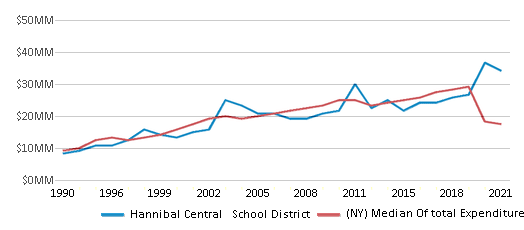
Revenue / Student
$29,805
$31,307
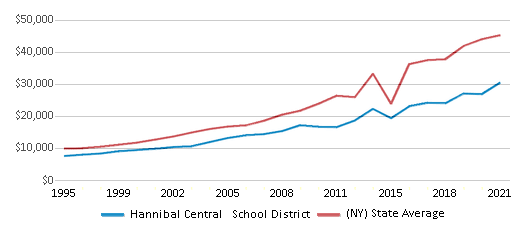
Spending / Student
$32,983
$32,183
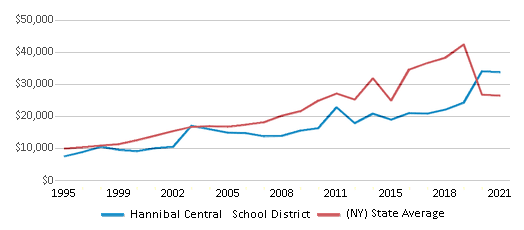
Best Hannibal Central School District Public Middle Schools (2025)
School
(Math and Reading Proficiency)
(Math and Reading Proficiency)
Location
Grades
Students
Rank: #11.
Kenney Middle School
(Math: 18% | Reading: 28%)
Rank:
Rank:
2/
Bottom 50%10
846 Cayuga St
Hannibal, NY 13074
(315) 564-8120
Hannibal, NY 13074
(315) 564-8120
Grades: 5-8
| 382 students
Recent Articles

Year-Round Or Traditional Schedule?
Which is more appropriate for your child? A year-round attendance schedule or traditional schedule? We look at the pros and cons.

Why You Should Encourage Your Child to Join a Sports Team
Participating in team sports has a great many benefits for children, there is no doubt. In this article you will learn what those benefits are.

White Students are Now the Minority in U.S. Public Schools
Increasing birth rates among immigrant families from Asia and Central and South America, combined with lower birth rates among white families, means that for the first time in history, public school students in the United States are majority-minority. This shift in demographics poses difficulties for schools as they work to accommodate children of varying language abilities and socio-economic backgrounds.





